NCERT Solutions for Class 4 EVS Chapter 3 - Nature Trail
| Table of contents |

|
| Page No. 37 |

|
| Page No. 39 |

|
| Page No. 40 |

|
| Page No. 43 |

|
| Page No. 44 |

|
| Page No. 45 |

|
| Page No. 47 |

|
| Page No. 49 |

|
| Page No. 50 |

|
| Page No. 52 |

|
| Page No. 55-56 |

|
Page No. 37
Write
Q1: Can you think of rules that should be followed while you are in a zoo or a forest?
For example,
(a) We should not feed birds.
(b) ___________________________
(c) ___________________________
(d) ___________________________
Now, look at the safety rules given below and match them with your list. Have you missed out any of the rules given?
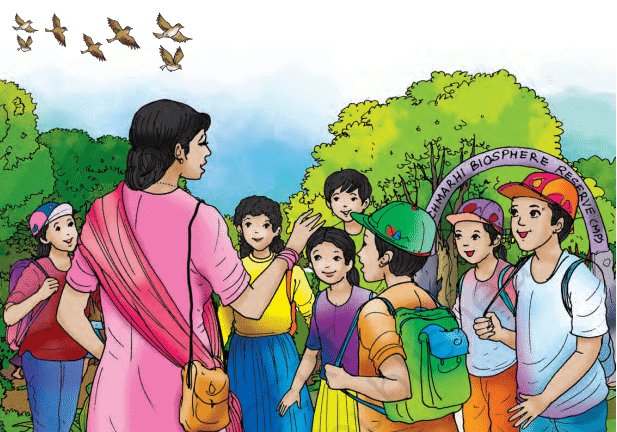 Safety RulesDOs and DON’Ts
Safety RulesDOs and DON’Ts
1. Please be careful in a new place.
2. Please do not tease animals.
3. Please do not feed animals.
4. Please do not damage trees, and flowers.
5. Please do not bring pets, firearms, or any kind of weapons.
6. Please do not bring polythene bags.
7. Please do not damage public utilities.
8. Please do not throw any garbage in the forest.
Ans: Here are some rules to follow in a zoo or forest:
(a) We should not feed birds.
(b) We should not tease animals.
(c) We should not throw garbage.
(d) We should not damage plants or trees.
These rules match the safety rules given on the page, like not feeding animals, not damaging trees, and not throwing garbage.
Discuss
Q: Why are these rules important to follow?
Ans: These rules help keep the forest clean and safe for animals, plants, and people.
Page No. 39
Activity 1
Q: Look closely at the picture and identify the animals. You may take help from your teacher.
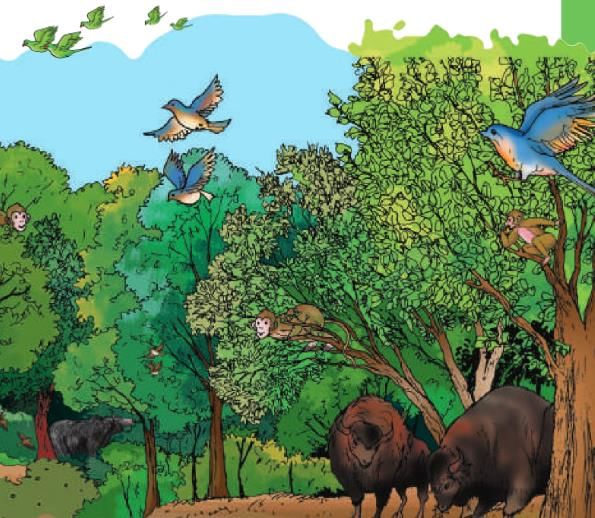 Divide them into two categories:
Divide them into two categories:Animals on land
Birds in the sky
Ans:
Animals on land:
- Bear
- Monkeys
- Bisons
- Parrots
- Blue Jay Birds
Page No. 40
Write
Q: Name some animals including the birds that you have seen. Write any one feature of each of them.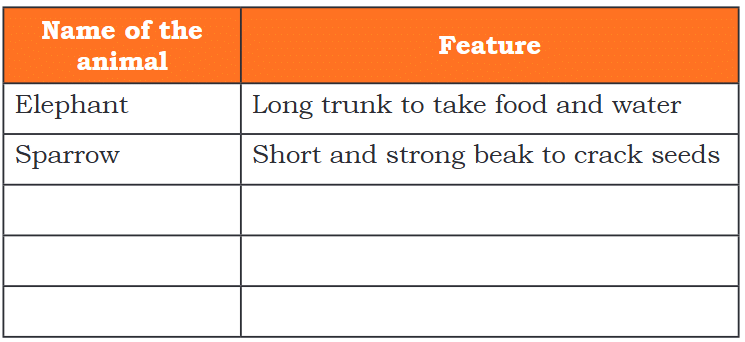 Ans:
Ans: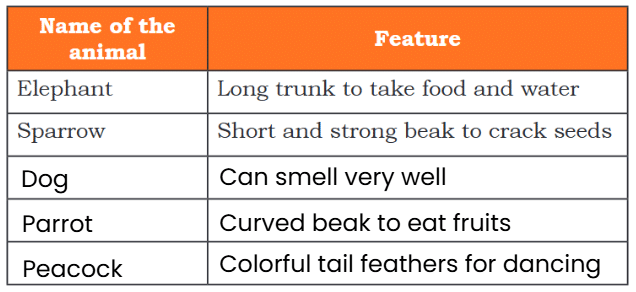
Write
Q: Compare the features of the Indian Giant Squirrel with the squirrels you see in your area.
Ans: The Indian Giant Squirrel is bigger and has red color. The local squirrel is smaller and usually grey or brown.
Page No. 43
Q1: Look at the footprints and guess the name of the animals that you think must have come to the pond to drink water.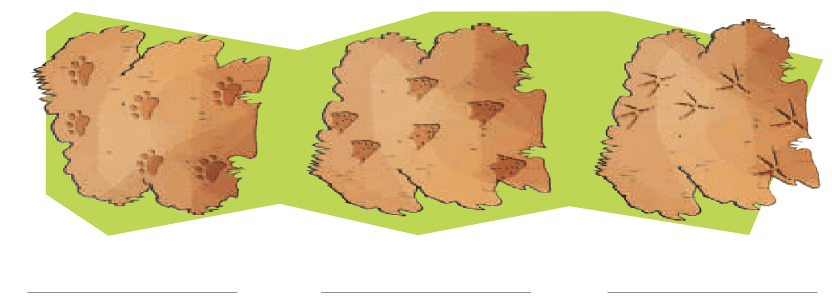 Ans:
Ans: 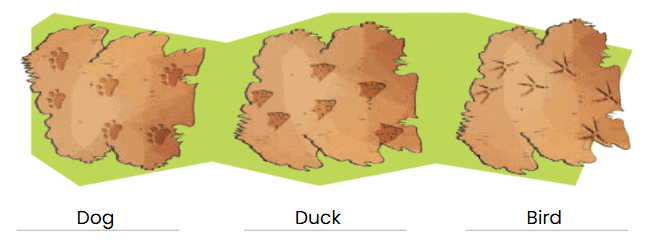
Q2: Observe and draw the footprint of any animal. Ans: Here are the foot prints of Horse:
Ans: Here are the foot prints of Horse: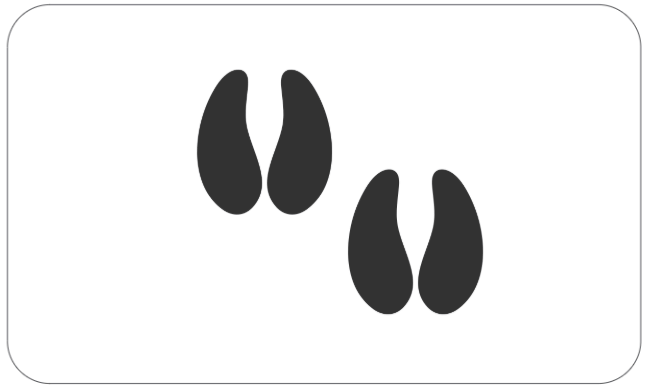
Page No. 44
Write
Q: Name the birds shown below.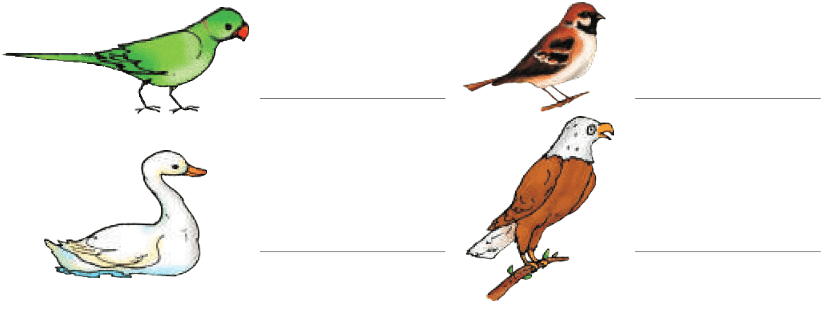 Ans:
Ans: 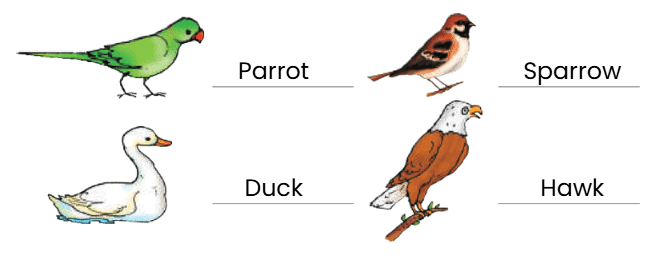
Page No. 45
Activity 3
Q: Take different food items like grains, berries, fruits, nuts, etc., in a plate. Try to pick these food items using a spoon, a toothpick or a pair of sticks. Fill the table below with appropriate tool(s) for picking each of these food items.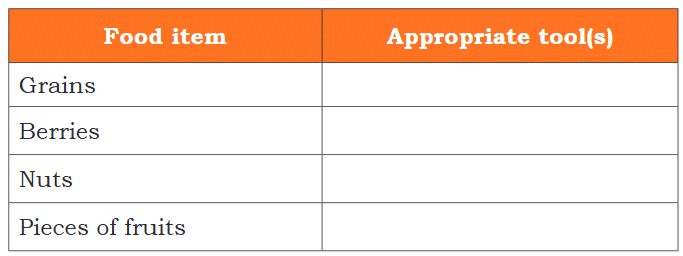 Ans:
Ans: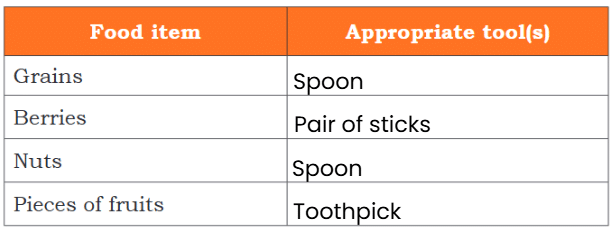
Page No. 47
Activity 4
Q1: Bird Diary
(a) Go near a tree.
(b) Close your eyes and listen to the sounds of different birds.
(c) Now open your eyes and focus on one bird at a time.
(d) Observe how it moves, what it eats, and where it sits.
(e) Write your observations in a Bird Diary!
For each bird, note the following: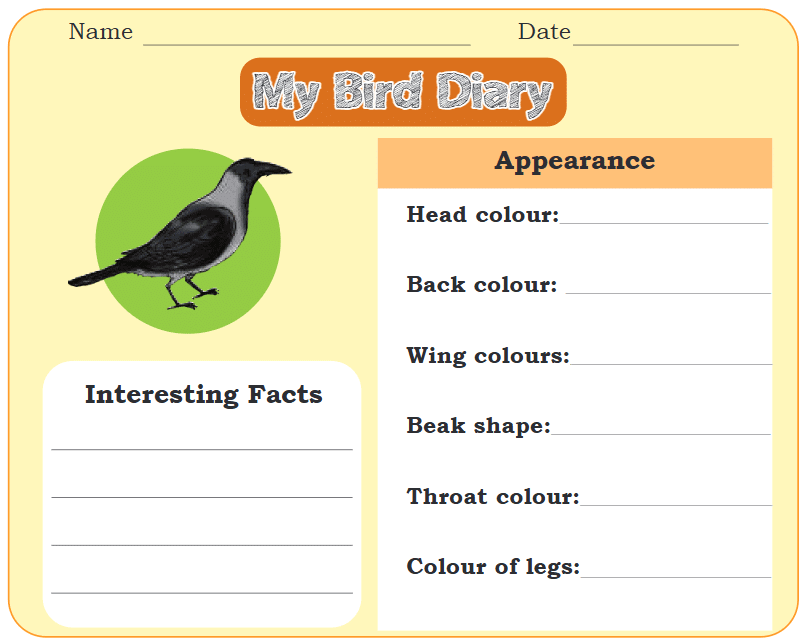 Ans:
Ans: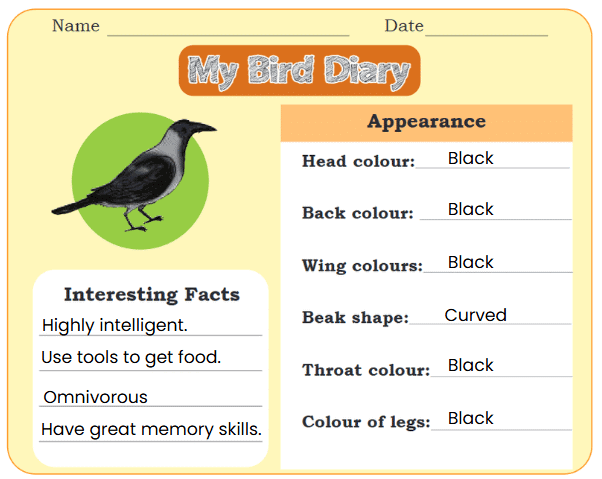
Q2: List the animals which live in and around water bodies. Fill in the table given below.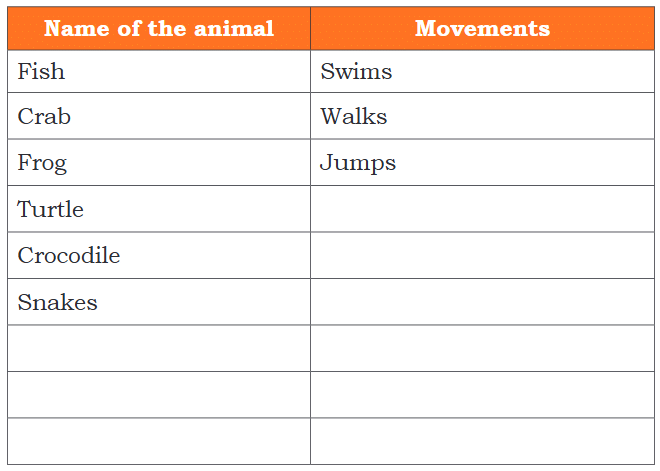 Ans:
Ans: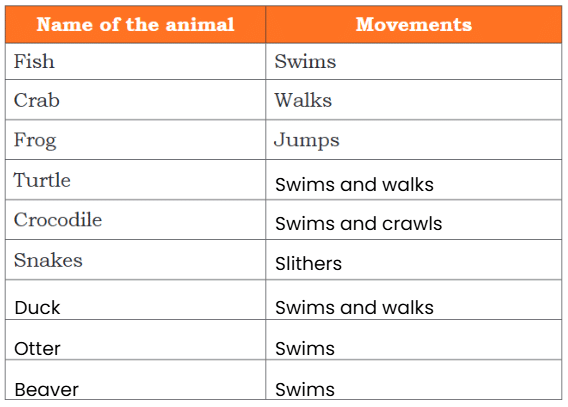
Page No. 49
Write
Q: What are the insects that you find at your home and in your surroundings?
Ans: Some insects I find at home and in my surroundings are:
- Ants
- Butterflies
- Bees
- Cockroaches
- Mosquitoes
Q2: Name the insects shown below.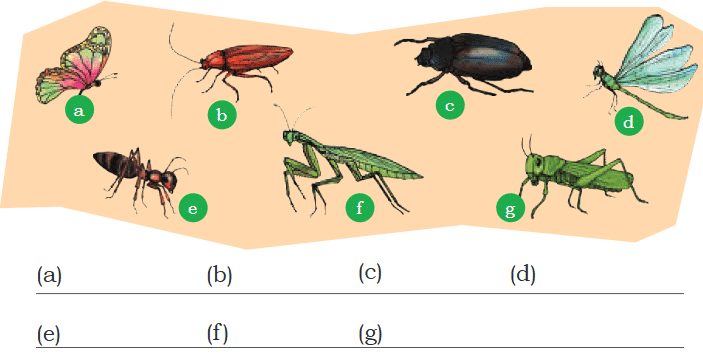 Ans:
Ans: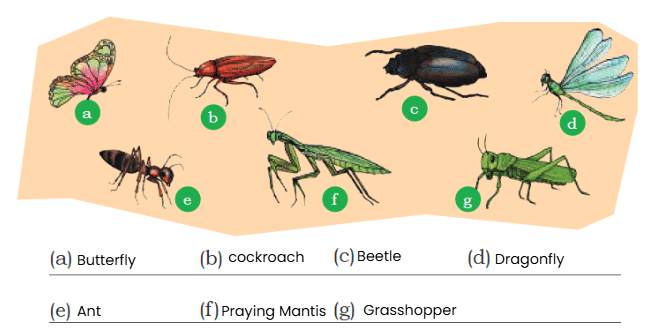
Page No. 50
Activity 5
Q 1: During the visit to the nature trail, students collected leaves from different plants. Help them identify the plants based on the pictures of the leaves given below.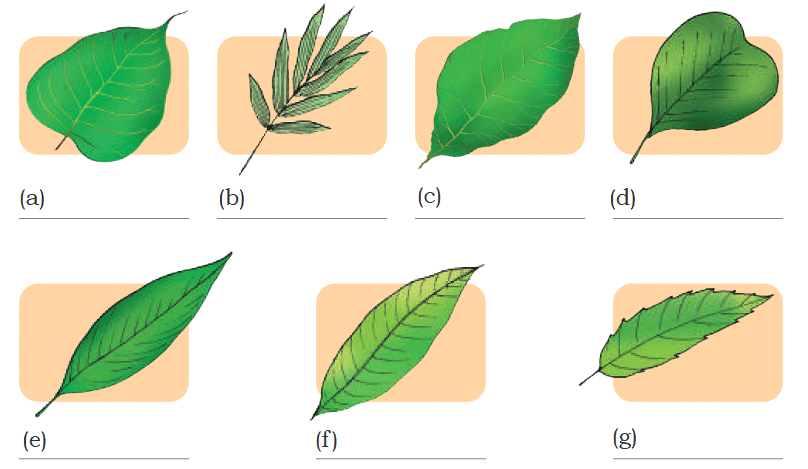
Ans: 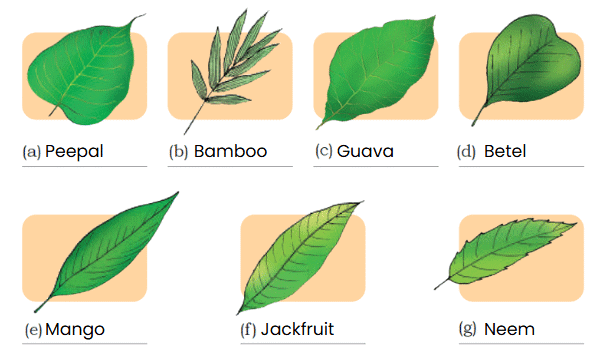
Q2: Observe the leaves of different plants in your neighbourhood and fill the table.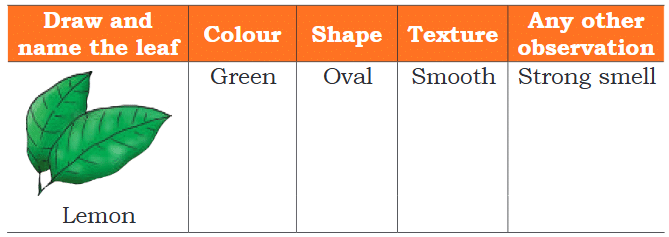
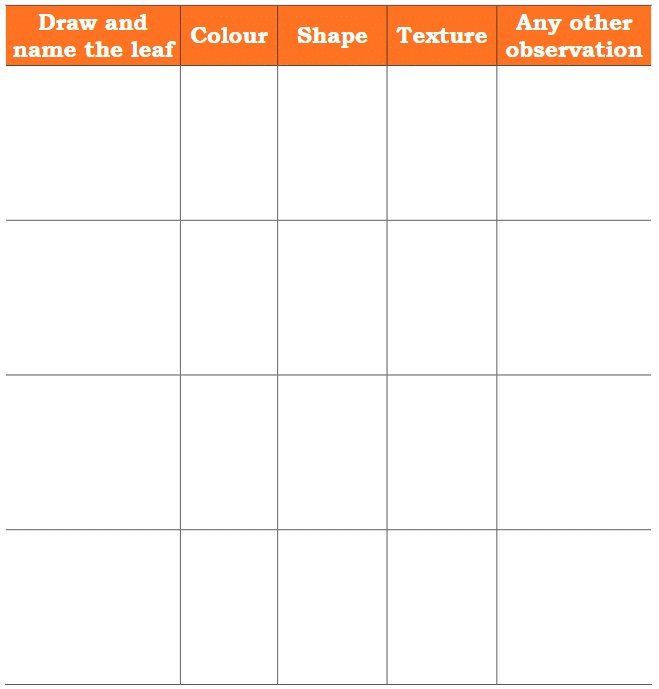 Ans:
Ans: 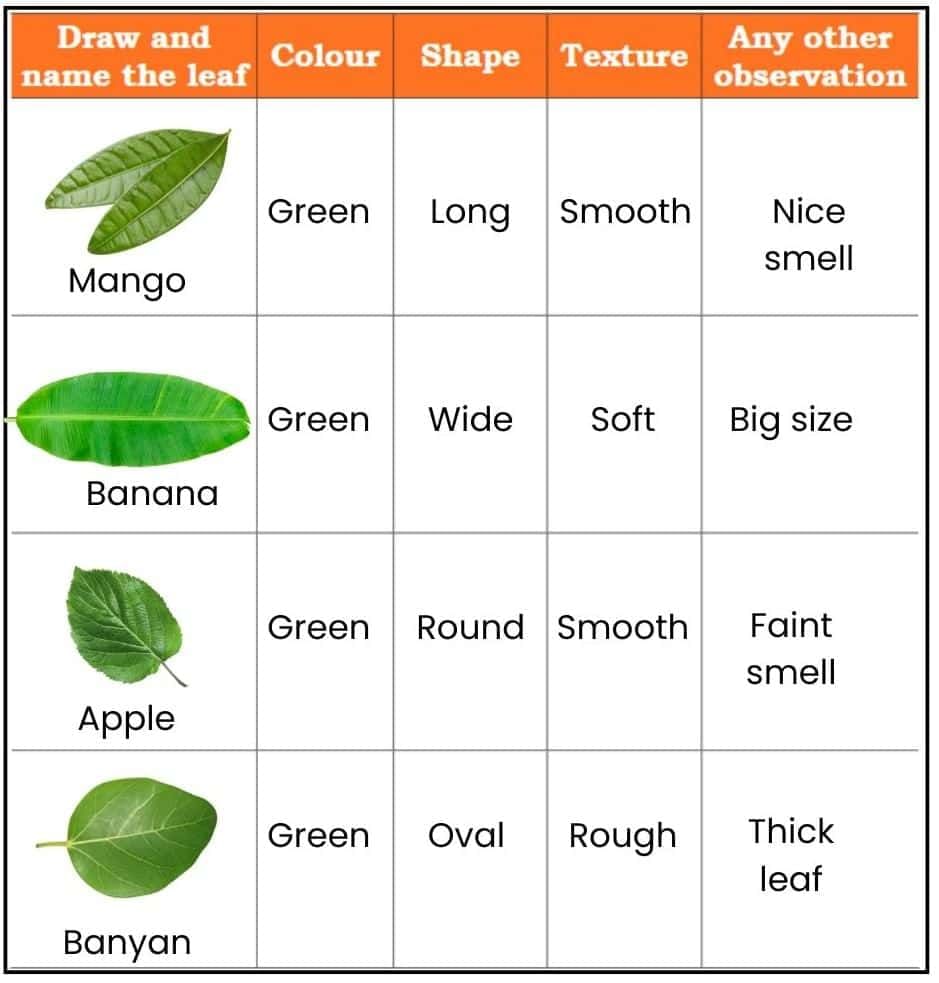
Page No. 52
Activity 6
Q: Leaf Autograph
Place a leaf on a notebook with the rough, vein-side facing up. Cover it with a plain sheet of paper. Rub a crayon over the paper, and watch the leaf’s shape appear like magic! Try this with different leaves and see how each one has its own unique pattern. Name the plant or tree to which the leaf belongs.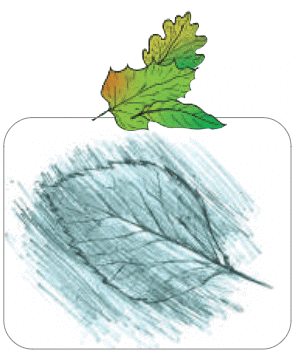 Ans: The leaf in the picture might be from an oak tree or a maple tree. To be sure, you can look at the shape, edges, and lines on the leaf. You can also check a book or ask an elder to help you find the right tree name.
Ans: The leaf in the picture might be from an oak tree or a maple tree. To be sure, you can look at the shape, edges, and lines on the leaf. You can also check a book or ask an elder to help you find the right tree name.
Q: Let us Play the Game ‘Web of Life’
Have you ever wondered how all living beings are connected? Let us find out by playing a game! You just have to imagine you are a part of nature—maybe a tree, a bird, or even the Sun. 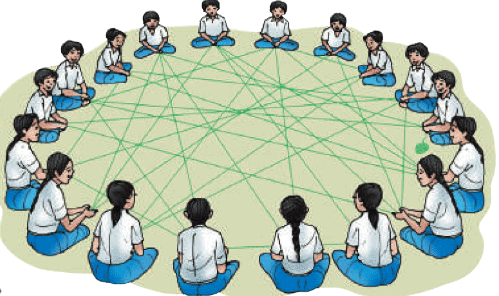
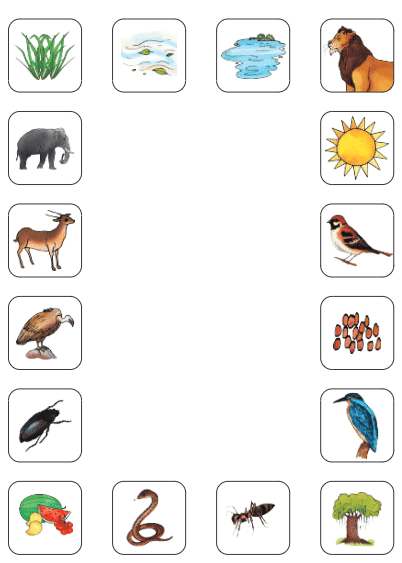
Ans:
Web of Life Connections with Lines
Here’s how to draw the lines between the items in the image
- Sun → Tree
- Tree → Bird (sparrow-like bird)
- Bird (sparrow-like bird) → Insect (ant)
- Insect (ant) → Plant (grass)
- Plant (grass) → Deer
- Deer → Lion
- Lion → Vulture (bird with long beak)
- Vulture → Snake
- Snake → Kingfisher (blue bird)
- Kingfisher (blue bird) → Pond (water with lily pads)
- Pond (water with lily pads) → Elephant
- Elephant → Fruits (watermelon and berries)
- Fruits (watermelon and berries) → Beetle (black insect)
- Beetle (black insect) → Stream (flowing water)
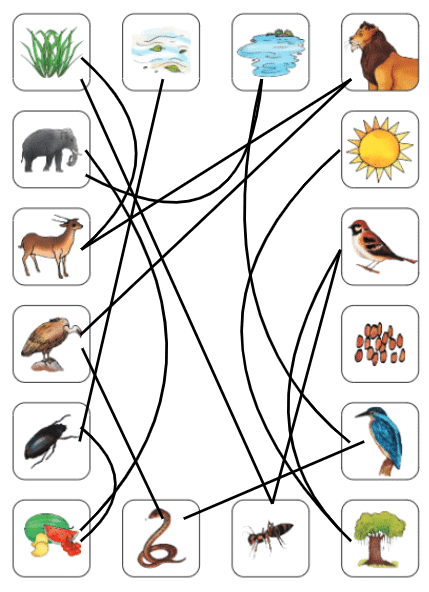
Page No. 55-56
Let us reflect
Q1: Which animal would you love to be? What special abilities would it give you?
Ans: I would like to be a bird. I could fly in the sky.
Q2: How do you think different plants and animals are dependent on each other?
Ans: Plants give food and shelter to animals. Animals help in pollination and seed spreading.
Q3: What is the role of a nature scientist?
Ans: A nature scientist studies plants and animals and teaches us how to protect them.
Q4: Solve the puzzle.
Find the treasures of the forest.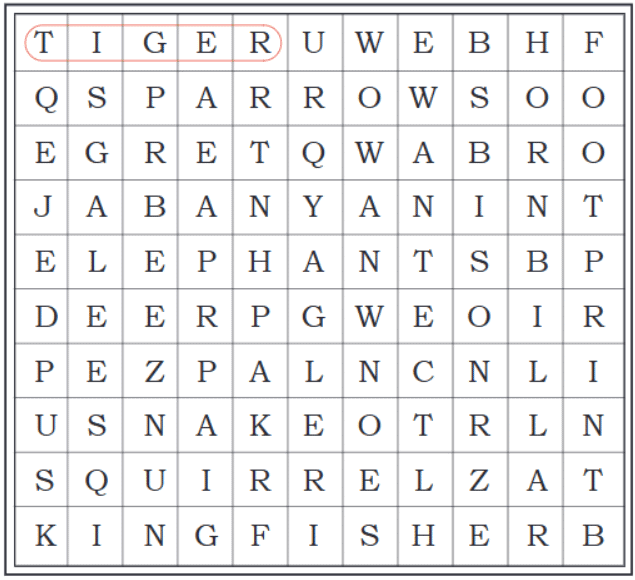 Ans:
Ans: 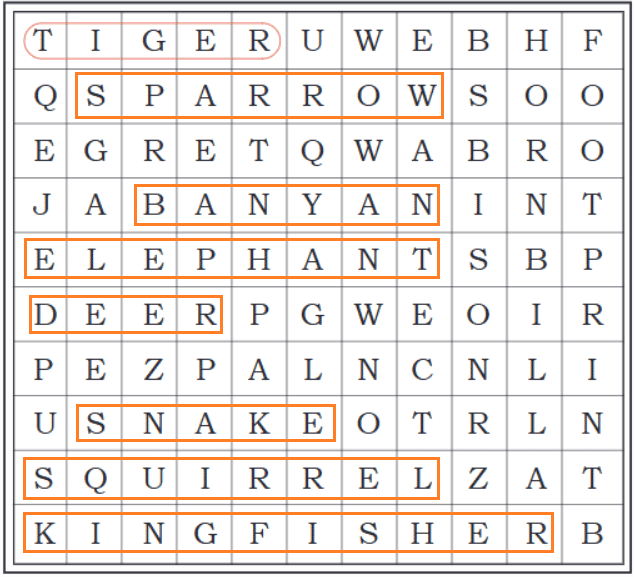
Q5: Take on the challenge
Plan a nature walk with your family or friends in a nearby park. To prepare yourself as a guide, identify few plants and animals, and study their features and interesting facts which you can explain during the walk.
Ans:
Nature Walk Plan for Class 4
Objective: To explore a nearby park, learn about plants and animals, and share interesting facts with your family or friends.
Preparation:
Choose a Park: Pick a nearby park with trees, plants, and animals.
Identify Plants:
Trees: Look for trees like Banyan, Mango, or Peepal.
Shrubs: Find smaller plants like hibiscus or jasmine.
Flowers: Spot colorful flowers like marigolds.
Identify Animals:
Birds: Look for sparrows, pigeons, or peacocks.
Insects: Watch for butterflies, bees, or ants.
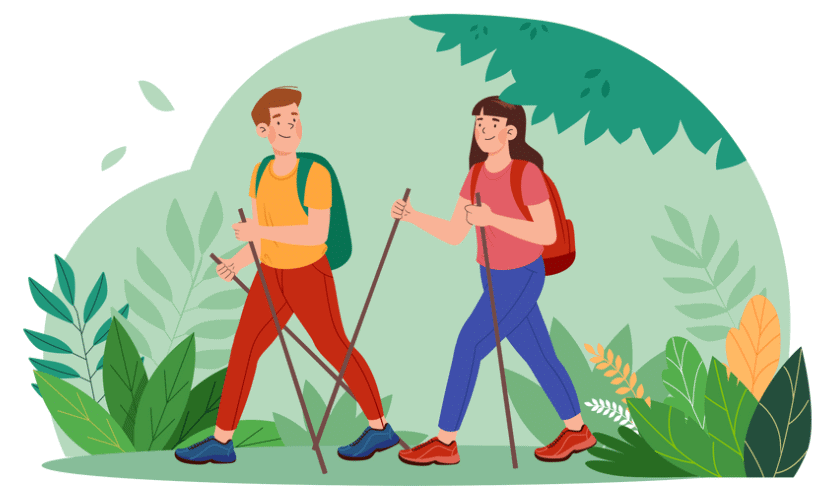
Interesting Facts:
- Banyan Tree: Has roots that grow from its branches.
- Peepal Tree: Considered sacred and is called the "tree of life."
- Mango Tree: Known as the "King of Fruits."
- Peacock: India’s national bird with beautiful feathers.
- Sparrow: A common bird that helps control insects.
What to Bring:
Comfortable shoes, a notebook, a camera, water, and snacks.
During the Walk:
- Guide the group: Share facts about the plants and animals.
- Ask Questions: “What animals live in these trees?” or “What do butterflies do?”
After the Walk:
Talk about what everyone learned and how to protect nature.
Enjoy your nature walk while learning and having fun!
Q6: Do an activity
Role-play: Create a scene of a forest in your classroom where students can perform roles of plants and animals, and of visitors. While enacting the play, focus on our role to protect animals and plants.
Ans: In this fun role-play activity, we will create a scene of a forest right in your classroom! Some students will pretend to be trees and plants, others will act as animals, and some will play the role of visitors (people). The goal of this role-play is to understand how important it is to protect trees, animals, and nature. Let’s get started!
Materials Needed:
- Chairs or desks to make the trees or rocks.
- Green paper or cloth to represent plants.
- Animal face masks or simple props (optional).
- Cards or signs for visitors (humans).
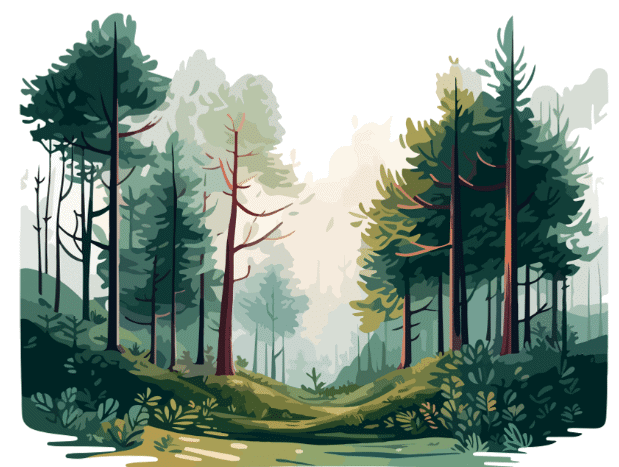
Roles:
Plants (Trees and Flowers): Some students will act like plants, standing or sitting still. They can make rustling sounds like leaves blowing in the wind.
Animals: Some students will pretend to be animals, like elephants, monkeys, birds, etc. They can move around and make animal sounds.
Visitors (Humans): Some students will pretend to be visitors (people) who come to the forest to explore. They should interact with the plants and animals but learn to protect them.
How to Set Up the Scene:
Create the Forest: Arrange desks or chairs around the classroom to look like a forest. Some desks will be trees (plants), and some students will act as animals in different parts of the forest.
Role-play Script: Each role can have a line to say. Here are a few examples:
Tree (Plant): “I help clean the air and give animals a home. Please don’t hurt me. I need your protection to stay strong.”
Elephant (Animal): “I need the trees to live in the forest. If the trees are cut down, where will I live?”
Visitor (Human): “I didn't know the forest was so important. I will help protect it and not harm the animals or plants.”
Teacher/Facilitator: Remind the students to protect nature during the play.
Role-play Steps:
Start the Play: The visitors (humans) enter the forest excitedly and start looking at the trees and animals.
Problem Happens: Some visitors might pretend to cut down trees or disturb the animals. This creates a problem in the forest.
Solution: The trees and animals speak up and tell the visitors how important it is to protect the forest. The visitors realize that they should care for the forest and promise to protect it.
Learning Outcome:
- Through this role-play, you will learn how important it is to take care of plants and animals.
- You will understand that everything in the forest is connected, and we all need to protect nature for it to stay healthy and happy.
By the end of the activity, you will know how to protect the environment and help others do the same!
Q7: Let us make a paper turtle! Try using an old newspaper or used paper.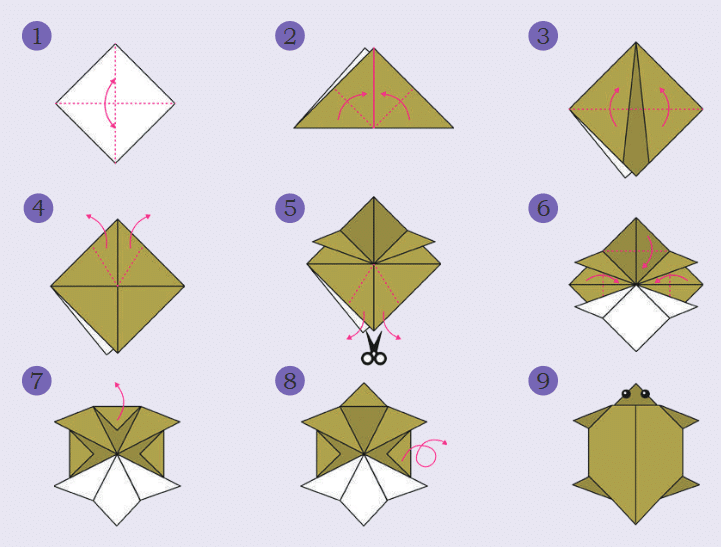 Ans: Now it’s your turn! Try making a cute paper turtle using old newspaper or used paper. Have fun folding and decorating it your way!
Ans: Now it’s your turn! Try making a cute paper turtle using old newspaper or used paper. Have fun folding and decorating it your way!
Q8: Find out
Write the name of your state animal, bird, and plant.
Ans: Here are 5 Indian states along with their respective animal, bird, and plant:
Madhya Pradesh
Animal: Barasingha (Swamp Deer)
Bird: Indian Roller
Plant: Banyan Tree
Karnataka
Animal: Indian Elephant
Bird: Indian Peafowl (Peacock)
Plant: Sandalwood Tree
West Bengal
Animal: Royal Bengal Tiger
Bird: White-throated Kingfisher
Plant: Mango Tree
Rajasthan
Animal: Camel
Bird: Great Indian Bustard
Plant: Khejri Tree
Tamil Nadu
Animal: Nilgiri Tahr
Bird: Grey Hornbill
Plant: Gloriosa Lily
|
21 videos|198 docs|10 tests
|
FAQs on NCERT Solutions for Class 4 EVS Chapter 3 - Nature Trail
| 1. What is the main theme of the 'Nature Trail' lesson in Class 4? |  |
| 2. How can students effectively participate in a nature trail? |  |
| 3. What are some activities that can be included in a nature trail for Class 4 students? |  |
| 4. Why is it important for children to learn about nature? |  |
| 5. What reflections can students make after completing a nature trail? |  |
















